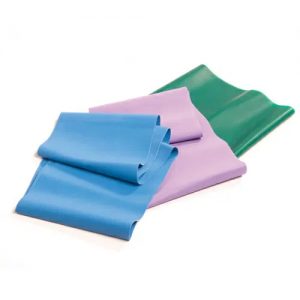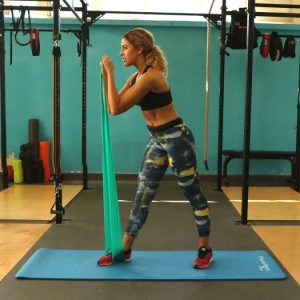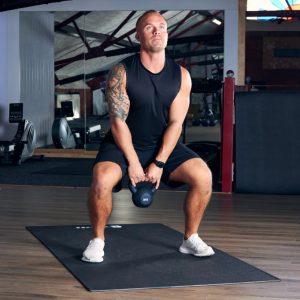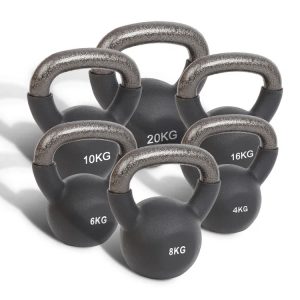You may find yourself debating whether to use resistance bands vs weights for strength training or physiotherapy. Both are great, but one might be better for your fitness goals. This guide breaks down their differences by explaining how they work and what exercises they are suitable for to help you choose.
Resistance Bands Explained

Resistance bands are like a bigger version of rubber bands—but stronger and thicker. Made from elastic material, such as latex or fabric, they can be stretched overhead to work muscles through a full range of motion. This adds a little extra snap to your strength training routine.
They might look simple, but they can be just as effective as traditional weights.
How do resistance bands work?

When you stretch a resistance band, your muscles have to work against the tension, similar to lifting weights or using machines. This targets areas like your shoulders, back, and arms, as well as your legs, depending on the workout.
When it comes to the design, there are loops and tubing with handles or anchors, among others. For reference, take a look at this standard Physiorom latex resistance band. It’s a flat, continuous loop made from stretchy latex. You increase the tension by holding both ends and pulling them apart.
For instance, you can place the band around your lower legs and step to one side. The resistance increases as you stretch the band with each step; it decreases when you bring your feet back together.
In contrast, foam handle resistance tubes, as the name suggests, are tube-like and come with handles. You can pull them in a similar way to the latex band, but the handles give you a better grip. The resistance is based on how much you stretch the tube. For shorter-distance movements, you can increase the resistance by looping the tube around your hand to make it shorter.
Say, you’re doing standing chest press. You could lie on your back with the band beneath you and push it up, the band stretching to create resistance as you do so. Or you could anchor it to a closed door or another object to perform the move standing.
Resistance bands increase in tension the further you stretch them. This means your exercises become more difficult towards the top end of a lift. This can be a great way to train if you’re having trouble completing full range of motion when lifting weights and want to focus on that last few inches.
They are also excellent for improving joint mobility and recovering from injury, because the low-impact nature of resistance bands lets you control the tension and range of motion. This helps gradually rebuild strength without putting undue stress on healing tissues.
Resistance bands are widely used in physical therapy for recovering from injuries like:
- Ligament tears (e.g. ACL, MCL)
- Rotator cuff injuries
- Tendonitis (e.g. tennis elbow)
- Post-surgery recovery (e.g. knee or hip replacements)
More resistance band exercises to try:
- Back exercises: Seated row, lat pulldown, and bent-over row.
- Shoulder exercises: Lateral raise, front raise, and overhead press.
- Chest exercises: Standing chest press, chest fly, and push-up with band.
- Arm exercises: Bicep curl, tricep extension, and tricep kickback.
- Leg exercises: Side steps, glute bridge, and squats.
Weights Explained

Weights are strength training tools used to build muscles and increase strength. They come in different varieties, including dumbbells, barbells, kettlebells, and weight plates.
Made from metal or sand-filled plastic, they provide a constant, steady load—unlike resistance bands that stretch and offer changing resistance. This consistency helps build strength because your muscles work against the same load throughout the exercise.
How do weights work?

When you lift weights, your muscles work to move the load, whether you’re curling it up or lowering it back down. In a bicep curl, for instance, the weight stays the same throughout the movement, helping build strength and endurance. The muscles can develop through a mixture of tension and micro-tears in the muscle tissue which will grow back larger through good recovery.
Regardless of the type of weight you use, the principle is the same: the weight delivers a constant resistance that your muscles must work against. This, in turn, promotes muscle growth as they adapt to the resistance over time.
Weights can deliver far higher levels of resistance than bands, ranging from light dumbbells to barbells weighing several hundred kilograms. This means that weights will take you a lot further in strength training and muscle building goals. That said, weights may not be suitable for everyone—particularly those with joint issues or injuries—since they place more strain on the body than resistance bands. Bands offer a gentler alternative for building strength with less joint stress
Weight training exercises to add to your routine:
Using dumbbells:
- Dumbbell chest fly
- Dumbbell overhead triceps extension
- Dumbbell shoulder press
- Dumbbell bicep curl
- Dumbbell goblet squat
Using barbells:
- Barbell bench press
- Barbell back squat
- Barbell deadlift
- Barbell bent-over row
- Barbell overhead press
Using kettlebells:
- Kettlebell swing
- Kettlebell goblet squat
- Kettlebell clean and press
- Kettlebell lunge
- Kettlebell Russian twist
Using weight plates:
- Plate front raise
- Plate halo
- Plate overhead press
- Plate squat press
Resistance Bands vs Weights: The Verdict
Resistance bands are handy if you want something light and easy to pack away. They’re great for home workouts, travelling, or adding a challenge. These bands are also a good choice if you’re easing into strength training or working around an injury.
Weights are better when you want to build serious strength. They’re easier to track progress with, especially when you’re trying to lift heavier over time.
Or, why not use both? You can use bands for warming up or working smaller muscle groups, and weights for your main lifts.


